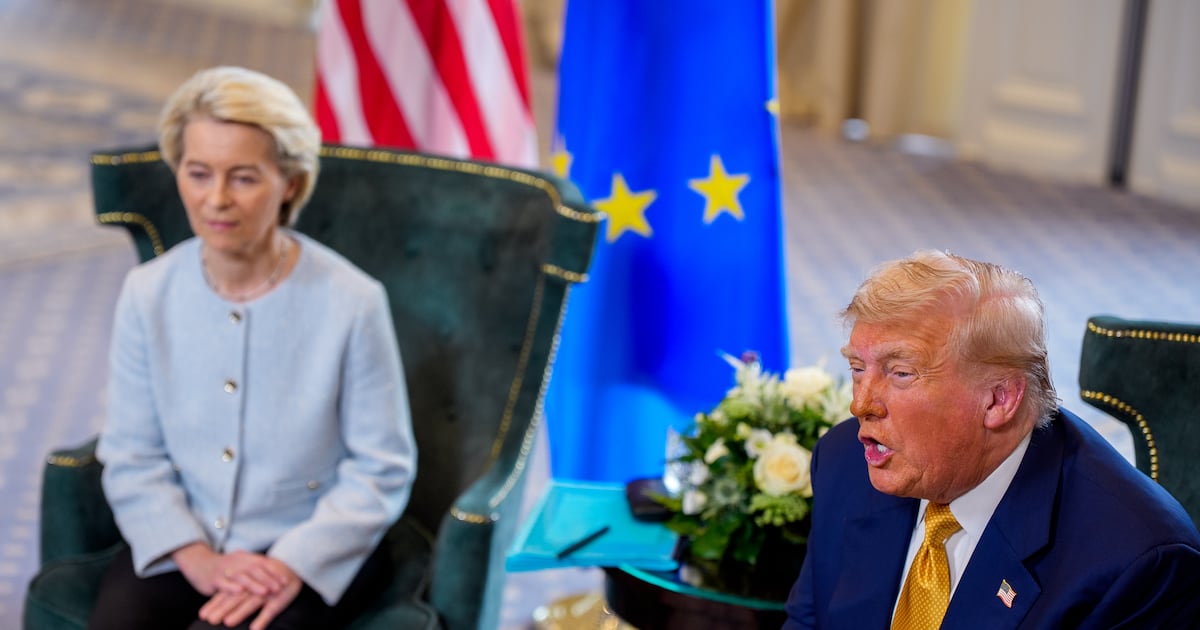The agreement of an outline trade deal between the EU and the US has one main advantage – it avoids an imminent tariffs war between the two sides which could have got nasty.
However sources say it would take some time to work out the full impact of the deal on Ireland, as key details remain either unclear or still to be worked out. Of vital interest will be whether – as European Commission president Ursula von der Leyen suggested in later comments, tariffs on pharma imports into the US would not rise from zero to 15 per cent, with risks of more to come.
US president Donald Trump had threatened 30 per cent tariffs on EU imports from August 1st and the EU had drawn up a list of US goods on which it would impose tariffs of its own.
This could have developed into a tit-for-tat battle. Now, the gunfight is off and the trade weapons are back in their holsters, at least for a while.
Ireland relies heavily on US investment and trade and stood to be particularly exposed if a trade war broke out. Such a scenario could risk drawing big digital tech companies with large operations here into the fallout.
Peace has broken out, but Trump’s unpredictable nature means dangers and uncertainties lie ahead. Businesses in most sectors will, for now at least, know what they are dealing with and that has a value it itself, as doubt had started to damage investment.
What about the terms of the deal? The 15 per cent tariff is well above the average of just under 5 per cent which applied on all EU imports to the US before Trump came to office. However, Irish businesses have been faced with a range of different tariff levels and much will depend on the small print of what was agreed.
It is worth remembering that Trump imposed 10 per cent tariffs on top of existing ones after “Liberation Day” and these remain in place. So, Irish companies will be calculating how the 15 per cent compares to the current position – and also to what applied before Trump came to power.
Indications on Sunday night were that the 15 per cent would be “all-inclusive” rather than adding to pre-existing tariffs. If that is the case, it would be welcome. While no details have been circulated, the EU said there would be “zero for zero” deals discussed in some areas. Drinks or agri-food could be in the frame here, which would be positive for Ireland.
Nonetheless, higher tariffs are an economic cost and Ireland will be calculating the impact on jobs and growth and what it means for the budget in October. And as yet the impact is unclear, with much remain either to be negotiated by the two sides on foot of the framework deal, or clarified.
[ The Irish Times view: a step towards stabilityOpens in new window ]
One sector which is vital to Ireland is the pharma and there was some confusion as to how it would be affected by the agreement struck on Sunday. European Commission president Ursula von der Leyen said that phar,a would be covered by the 15 per cent reciprocal tariffs. However, Trump said pharma was ” unrelated” to the deal.
The Trump administration is also examining key sectors like pharma and semiconductors – seen as vital to national security – under a separate process known as the section 232 studies and Trump may see this as his driver of policy in this area.
How this pans out is of vital interest to Ireland. The fact that pharma has escaped from tariffs so far has helped Ireland and limited the impact here of Trump’s policies. Ministers will want to know first whether the US intends to apply the 15 per cent tariff rate to pharma in the short term, as von der Leyen appeared to suggest. She said there would be exceptions in some areas of chemicals and generic drugs.
Beyond that, Ministers will want to establish whether Trump has left the door open for higher tariffs under the 232 process. This does, indeed, appear to be the case.
Trump spoke again on Sunday, before the negotiating part of the meeting, about his determination to bring pharma investment back home for security reasons. And he has spoken before about the possibility of using tariffs to achieve this – including as a threat in a year to 18 months time if companies have not relocated production to the US. Other policy options would also be open to Trump to try to get pharma firms to relocate away from countries like Ireland. The generally better mood between the EU and US may help in areas like this, but dangers remain for Ireland.
In the wider picture, Trump is building in baseline tariffs of 15 per cent for many countries, with his key goal being to raise revenue for the US exchequer. But this will hit those who rely on imports into the US, too, affecting businesses and consumers and pushing up inflation.
That is the price of tariffs. For now, though, Trump is happy for the US to pay it.

